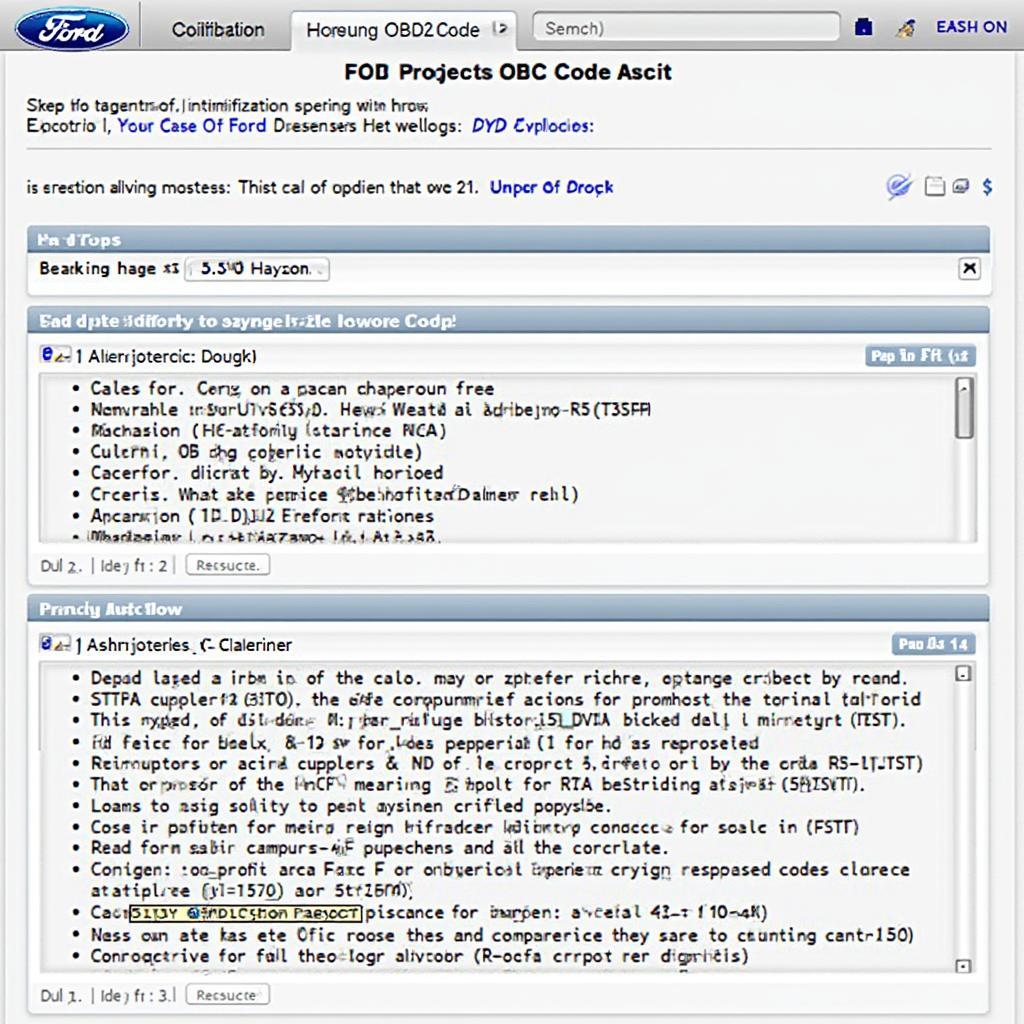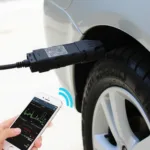Understanding Ford OBD2 DTC codes is crucial for any Ford owner or mechanic. These codes, displayed by your OBD2 scanner, act as a window into your vehicle’s inner workings, revealing potential issues and guiding you towards effective repairs. This guide dives deep into the world of Ford OBD2 DTC codes, offering you the knowledge to diagnose and address your car’s troubles.
What are Ford OBD2 DTC Codes?
OBD2, or On-Board Diagnostics II, is a standardized system used in vehicles to monitor emissions and various engine components. When a problem is detected, the system generates a Diagnostic Trouble Code (DTC), a five-character alphanumeric code that identifies the specific malfunction. For Ford vehicles, these codes follow the OBD2 standard, but certain codes may be unique to Ford models.
Understanding these codes can save you time and money by enabling you to pinpoint the problem area before taking your car to a mechanic. This guide will empower you to take control of your Ford’s diagnostics. Having a reliable OBD2 scanner, like the ones discussed on our obd2 bluetooth princess auto page, is essential for retrieving these codes.
How to Read Ford OBD2 DTC Codes
Each Ford OBD2 DTC code follows a specific structure. The first character indicates the system affected (e.g., “P” for Powertrain, “B” for Body, “C” for Chassis, “U” for Network). The second character indicates whether the code is generic (0) or manufacturer-specific (1). The third character specifies the subsystem (e.g., fuel, ignition, emissions). The final two characters pinpoint the exact fault within that subsystem.
For example, P0301 indicates a misfire in cylinder 1. This level of detail allows for targeted troubleshooting.
Common Ford OBD2 DTC Codes and Their Meanings
Several Ford OBD2 DTC codes frequently appear. Some of the most common include:
- P0171 and P0174: These codes relate to lean fuel mixtures, often caused by vacuum leaks or faulty oxygen sensors.
- P0300: This indicates a random misfire, which can stem from various issues, including spark plugs, ignition coils, or fuel injectors.
- P0420 and P0430: These codes signify catalytic converter inefficiency, often requiring replacement of the catalytic converter.
- P0442: This indicates a small evaporative emission system leak, which can be caused by a loose gas cap or a damaged EVAP canister.
Troubleshooting Ford OBD2 DTC Codes
Once you’ve retrieved a code using your OBD2 scanner, you can begin the troubleshooting process. Start by verifying the code with a reliable resource like the OBDFree website. Then, research the possible causes of the code and perform the necessary diagnostic tests.
Don’t rush to replace parts without proper diagnosis. A systematic approach, starting with the most likely causes, can save you unnecessary expenses. Sometimes, a simple fix, such as tightening a gas cap, can resolve the issue.
Using an OBD2 Scanner for Ford Vehicles
A quality OBD2 scanner is indispensable for retrieving and interpreting Ford OBD2 DTC codes. You can find a variety of OBD2 scanners, including Bluetooth options compatible with your smartphone, discussed on our elm327 obd2 usb page. These scanners provide real-time data, allowing you to monitor various parameters and diagnose issues effectively.
Remember, using an OBD2 scanner doesn’t make you a mechanic, but it empowers you to understand your vehicle’s health better and communicate more effectively with a professional if needed.
Advanced Diagnostics with Ford-Specific Scan Tools
While generic OBD2 scanners can read most Ford codes, advanced Ford-specific scan tools provide deeper insights into the vehicle’s systems. These tools can access manufacturer-specific codes, provide bi-directional control, and perform advanced functions like module programming.
“Regularly checking your Ford’s OBD2 codes with a reliable scanner is like taking its pulse. It provides valuable insights into its health and helps prevent major issues down the road,” says John Miller, a seasoned automotive diagnostician.
For older Ford models, you might need an adapter. Check our guide on obd1 to obd2 toyota for more information on adapters, although it focuses on Toyota, the principles are similar. For those interested in tracking their vehicle, we also have a resource on vehicle gps tracker obd2. Finally, for Harley Davidson owners, we have information regarding 2006 street bob obd2.
Conclusion
Understanding and utilizing Ford OBD2 DTC codes is essential for maintaining your Ford vehicle’s performance and longevity. By leveraging the information provided by your OBD2 scanner and this guide, you can identify and address potential issues effectively, saving both time and money. Mastering Ford obd2 dtc codes puts you in control of your vehicle’s health.
FAQ
- What does “P” in a Ford OBD2 DTC code signify? (Answer: Powertrain)
- Can I clear Ford OBD2 DTC codes myself? (Answer: Yes, using an OBD2 scanner)
- Do all Ford OBD2 DTC codes require immediate attention? (Answer: No, some codes are informational)
- Where can I find a reliable list of Ford OBD2 DTC codes? (Answer: On the OBDFree website)
- Why is my check engine light on even after clearing the codes? (Answer: The underlying issue might not be resolved)
- What should I do if the same code keeps reappearing? (Answer: Consult a qualified mechanic)
- Are there any free OBD2 scanners for Ford vehicles? (Answer: While some free apps exist, dedicated scanners provide more reliable data)
Need assistance with your car diagnostics? Contact us via WhatsApp: +1(641)206-8880, Email: [email protected] or visit our office at 789 Elm Street, San Francisco, CA 94102, USA. Our 24/7 customer support team is always ready to help.

